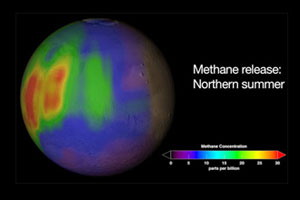 Methane concentrations revealing a plume in Mars' northern
Methane concentrations revealing a plume in Mars' northern
hemisphere during its summer season. Credit: NASAMethane on Mars? Really? What does that mean?
We've known about the existence of methane gas on Mars for several years now, from independent observations. Further observations have led to the detection of "plumes" or clouds of methane gas apparently emanating from specific locations on Mars. One plume is estimated to contain 19,000 metric tons of the stuff.
Why is this exciting news? If you know anything about the source of most of Earth's atmospheric methane gas, you already know the answer: possible life. Not, I should say, necessarily life on Mars, but maybe a strong piece of evidence in that direction.
On Earth, methane (CH4) is produced by living organisms---mostly by the activity of microbes, but some by the digestive processes in larger organisms (yes, like humans, and cows). Methane is the major constituent of natural gas, which fuels gas powered ovens and heaters in homes, as well as natural gas power plants. Methane is also produced by decaying organic matter---that's where "swamp gas" comes from.
On Mars, methane gas cannot exist for long in the atmosphere; it is relatively quickly broken down by solar radiation. So, the methane detected in Mars' atmosphere must be replenished by something, continually.
